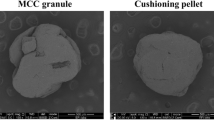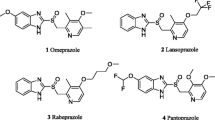Abstract
The purpose of this study was to evaluate the nature of film formation on tablets with different compositions, using confocal laser scanning microscopy (CLSM), and to measure film adhesion via the application of a novel “magnet probe test”. Three excipients, microcrystalline cellulose (MCC), spray-dried lactose monohydrate, and dibasic calcium phosphate dihydrate, were individually blended with 0.5% magnesium stearate, as a lubricant, and 2.5% tetracycline HCl, as a fluorescent marker, and were compressed using a Carver press. Tablets were coated with a solution consisting of 7% hydroxypropyl methylcellulose (HPMC) phthalate (HP-55), and 0.5% cetyl alcohl in acetone and isopropanol (11:9). The nature of polymer interaction with the tablets and coating was evaluated using CLSM and a designed magnet probe test. CLSM images clearly showed coating efficiency, thickness, and uniformity of film formation, and the extent of drug migration into the film at the coating interfaces of tablets. Among the excipients, MCC demonstrated the best interface for both film formation and uniformity in thickness relative to lactose monohydrate and dibasic calcium phosphate dihydrate. The detachment force of the coating layers from the tablet surfaces, as measured with the developed magnet probe test, was in the order of MCC>lactose monohydrate>dibasic calcium phosphate dihydrate. It was also shown that the designed magnet probe test provides reliable and reproducible results when used for measurement of film adhesion and bonding strength.
Similar content being viewed by others
References
Porter SC, Bruno CH. Coating of pharmaceutical solid-dosage forms. In: Liebeman HA, Lachman L, eds. Pharmaceuutical Dosage Forms: Tablets. New York, NY: Marcel Dekker, 1982: 77–151.
Frisbee SE, Mehta KA, McGinity JW. Processing factors that influence the in vitro and in vivo performance of film-coated drug delivery systems. Drug Deliv. 2002;2:72–76.
Nadkarni PD, Kildsig DO, Kramer PA, Bander GS. Effect of surface roughness and coating solvent on film adhesion to tablets. J Pharm Sci. 1975;64:1554–1557.
Rowe RC. The measurement of the adhesion of film coatings to tablet surfaces: The effect of tablet porosity, surface roughness and film thickness. J Pharm Pharmacol. 1978;30:343–346.
Khan H, Fell JT, Macleod GS. The influence of additives on the spreading coefficient and adhesion of a film coating formulation to a model tablet surface. Int J Pharm. 2001;227:113–119.
Rowee RC. The adhesion of film coatings to tablet surfaces-measurement on biconvex tablets. J Pharm Pharmacol. 1977;29:58–59.
Cole G, Hogan J, Aulton M. Pharmaceutical Coating Technology. London, UK: Taylor & Francis; 1995.
Felton LA. Recent advances in the study of polymeric film coating. AAPS Newsmagazine. 2003;6:28–31.
Missaghi S, Johnson M, Fassihi R. Assessment of film formation on different tablets using textural analysis and confocal laser scanning microscopy. Poster presented at: AAPS Annual Meeting and Exposition of the American Association of Pharmaceutical Scientists; November 10–14, 2002. Toronto, ON, Canada.
Sung LP, Nadal ME, Stutzman P, McKnight ME. Characterization of coating microstructure using laser scanning confocal microscopy. Polym Mater: Sci Eng. 2000;83:343–344.
Lamprecht A, Schäfer U, Lehr CM. Structural analysis of microparticles by confocal laser scanning microscopy. AAPS Pharm Sci Tech. 2000;1(3):article 17. Available at: http://www.aapspharmscitech.org.
George N. Confocal microscope systems—a comparison of technologies. Biosci Technol. 2003;28:12–14.
Cutts LS, Hibberd S, Adler J, Davies MC, Melia CD. Characterizing drug release processes within controlled release dosage forms using the confocal laser scanning microscopy. J. Control Release. 1996;42:115–124.
Adler J, Arvind J, Melia CD. A method for quantifying differential expansion within hydrating hydrophilic matrixes by tracking embedded fluorescent microspheres. J Pharm Sci. 1999;88:371–377.
Guo HX, Heinamaki J, Yliruusi J. Characterization of particle deformation during compression measure by confocal laser scanning microscopy. Int J Pharm. 1999;186:99–108.
McKnight ME, Martin JW, Galler M. Workshop on advanced methods and models for appearance of coatings and coated objects. J Res Natl Inst Stand Technol. 1997;102:489–498.
Felton LA, McGinity JW. Adhesion of polymeric films to pharmaceutical solids. Eur J Pharm Biopharm. 1999;47:3–14.
Strong J. On the cleaning of surfaces. Rev Scient Instrum. 1935;6:97–98.
Felton LA, Shah NH, Zhang G, Infeld MH, Malick AW, McGinity JW. Physical-mechanical properties of film-coated soft gelatin capsules. Int J Pharm. 1996;127:203–211.
Heavens OS. Adhesion of metal films produced by vacuum evaporation. J Phys Radium. 1950;11:355–360.
Wood JA, Harder SW. The adhesion of film coatings to the surfaces of compressed tablet. Can J Pharm Sci. 1970;5:18–23.
Fung RM, Parrott EL. Measurement of film coating adhesiveness. J Pharm Sci. 1980;69:439–441.
Johnson BA, Zografi G. Adhesion of hydroxypropyl cellulose films to low energy solid substrates. J Pharm Sci. 1986;75:529–533.
Wade A, Weller PJ. Handbook of Pharmaceutical Excipients. Washington, DC: American Pharmaceutical Association; 1994.
Author information
Authors and Affiliations
Rights and permissions
About this article
Cite this article
Missaghi, S., Fassihi, R. A novel approach in the assessment of polymeric film formation and film adhesion on different pharmaceutical solid substrates. AAPS PharmSciTech 5, 29 (2004). https://doi.org/10.1208/pt050229
Received:
Accepted:
DOI: https://doi.org/10.1208/pt050229




